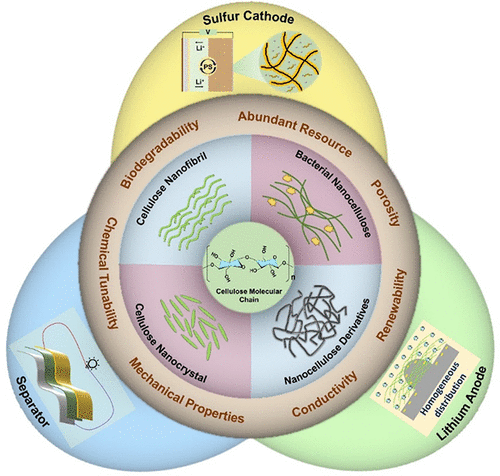当前位置:
X-MOL 学术
›
ACS Mater. Lett.
›
论文详情
Our official English website, www.x-mol.net, welcomes your feedback! (Note: you will need to create a separate account there.)
Nanocellulose and Its Derivatives toward Advanced Lithium Sulfur Batteries
ACS Materials Letters ( IF 11.4 ) Pub Date : 2021-07-01 , DOI: 10.1021/acsmaterialslett.1c00210 Yiju Li 1 , Yin Zhou 1 , Yousaf Muhammad 1, 2 , Jinhui Zhou 1 , Ziqi Guo 1 , Hao Tan 1 , Shaojun Guo 1, 3
ACS Materials Letters ( IF 11.4 ) Pub Date : 2021-07-01 , DOI: 10.1021/acsmaterialslett.1c00210 Yiju Li 1 , Yin Zhou 1 , Yousaf Muhammad 1, 2 , Jinhui Zhou 1 , Ziqi Guo 1 , Hao Tan 1 , Shaojun Guo 1, 3
Affiliation

|
Lithium sulfur batteries (LSBs) with a potentially high energy density are regarded as one of the most promising next-generation battery technologies. Nevertheless, the further development of LSBs is greatly hindered by some scientific issues, such as severe polysulfide shuttling and irreversible Li stripping/plating. Nanocellulose-based materials have triggered extensive attention in the development of advanced LSBs, because of their abundant source, good biodegradability and renewability, excellent mechanical and thermal properties, and flexible chemical tunability. In this perspective, we first present the fundamental operating principle and outline the main challenges of LSBs. Subsequently, the structure and properties of nanocellulose are briefly summarized, and the main research advancements of nanocellulose and its derivatives toward advanced LSBs are comprehensively reviewed. At last, the outlook with regard to the development of nanocellulose-based materials and their application in LSBs is provided.
中文翻译:

纳米纤维素及其衍生物用于先进锂硫电池
具有潜在高能量密度的锂硫电池(LSB)被认为是最有前途的下一代电池技术之一。然而,LSBs的进一步发展受到一些科学问题的极大阻碍,例如严重的多硫化物穿梭和不可逆的锂剥离/电镀。纳米纤维素基材料由于其来源丰富、生物降解性和可再生性良好、优异的机械和热性能以及灵活的化学可调性,在先进 LSB 的开发中引起了广泛关注。从这个角度来看,我们首先介绍基本工作原理并概述 LSB 的主要挑战。随后,简要总结了纳米纤维素的结构和性能,并全面回顾了纳米纤维素及其衍生物在先进 LSB 方面的主要研究进展。最后,对纳米纤维素基材料的发展及其在LSBs中的应用进行了展望。
更新日期:2021-08-02
中文翻译:

纳米纤维素及其衍生物用于先进锂硫电池
具有潜在高能量密度的锂硫电池(LSB)被认为是最有前途的下一代电池技术之一。然而,LSBs的进一步发展受到一些科学问题的极大阻碍,例如严重的多硫化物穿梭和不可逆的锂剥离/电镀。纳米纤维素基材料由于其来源丰富、生物降解性和可再生性良好、优异的机械和热性能以及灵活的化学可调性,在先进 LSB 的开发中引起了广泛关注。从这个角度来看,我们首先介绍基本工作原理并概述 LSB 的主要挑战。随后,简要总结了纳米纤维素的结构和性能,并全面回顾了纳米纤维素及其衍生物在先进 LSB 方面的主要研究进展。最后,对纳米纤维素基材料的发展及其在LSBs中的应用进行了展望。


























 京公网安备 11010802027423号
京公网安备 11010802027423号